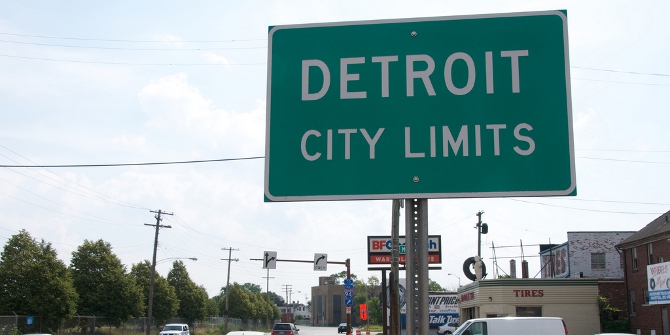 In the third piece on The State of the States, Chris Gilson outlines the case study approach used by the platform, and how it can be useful for policymakers working in US state and local governments.
In the third piece on The State of the States, Chris Gilson outlines the case study approach used by the platform, and how it can be useful for policymakers working in US state and local governments.
It’s impossible to know everything and have all the information needed to do your job without consulting others both inside and outside your organisation. In my earlier post I outlined how those working in US state and local government often didn’t have the right information they need to do their jobs as effectively as possible because they were too busy, were affected by poor institutional memory or had limited information networks which constrained what they were able to learn and from who.
These problems can be a significant barrier for public servants who want to do the best for their constituents. With the rise of the use of digital tools to share and spread information, could such tools be the answer to public servants’ information problem. In my last post, I introduced The State of the States, a digital tool currently being developed by the LSE Phelan United States Centre. As part of The State of the States platform we’re developing a database of policy case studies covering key policy areas. These case studies give readers a quick indication of the impact and effectiveness of policies which have been implemented in US states and local areas. Crucially, unlike many other measures of policy implementation and impact, these case studies also show which policies have been effective and those which have not been or have had mixed results.
How case studies can be useful in policy learning
A case study is fundamentally a story about how something happened and why. Often used as a teaching tool, including at LSE, case studies provide an organised history of an event or issue, including the background context (including who and where), who did what and why, and the outcome. Given this information, case studies can encourage those who read them to think about how to approach and tackle problems using real-world examples. It’s also worth noting that, if properly and consistently recorded, case studies can act as a form of institutional or topic memory, making what is often tacit knowledge explicit.
In addition to being teaching tools, case studies are increasingly used in the social sciences and can play a key role in studying policy analysis, and learning from policies and their implementation. Case studies can also help their users to determine why policy successes and failures occur and how these outcomes differ from what is normally seen in policy implementation. In recent work, scholars Maria Gonzalez de Asis and Jennifer Widner outline what makes a good or effective case study, including that they should: draw on a shared language in that policy domain; be structured in a way that allows cases to be compared; entertain multiple explanations for the outcome; have essential operational details; pay attention to, but is not focused on, politics; discuss the case context; and finally (and very importantly) be engaging to read. Effective case studies can also include qualitative and quantitative methods to help understand policy contexts and outcomes.

How The State of the States uses case studies
When building The State of the States as a useful tool for policymakers, we took many of the factors mentioned above into account. The internet is full of noise, with advertising and pop-ups vying for attention and often interrupting the flow of useful information. We have created a specific rubric for case studies on The State of the States platform to help users find the information they need quickly. Our case study categories are evidence based and for now, each case study is researched by the State of the States team with the aim of providing an easy-to-read summary of what are often very complex issues (read a sample case study from 2022 on California homelessness policy). Each case study on The State of the States uses the following:
Narrative title
Drawing on more than 14 years’ experience working on LSE blog ands academic communication more widely, each case study has a title which tells a story. Readers can get a quick sense of the main point outlined in the case study, and the effectiveness or not of a policy, simply by reading this narrative title.
Abstract/Summary
As with the title, the case study summary gives an overview of the policy being discussed and presents the main discussion points and evidence.
Problem
The problem is at the heart of every case study on The State of the States. What is the issue policymakers are trying to tackle? What is the outcome they hope to achieve? What efforts have been made in the past to address the problem, and have they been successful?
Solution Approach
This section gives the background to the policy measure taken to address the problem previously outlined. How was the policy decided on, and by who? Was it the result of new legislation, or a new or modified implementation strategy? Were political coalitions needed for this solution to happen?
Solution Implementation
How was the policy put into practice, and by who? Did the implementation of the policy go as planned, or were there difficulties, either foreseen or unforeseen? How long did it take to put in place, and how was its effectiveness monitored and by who?
Impact and effectiveness
Did the policy do what it set out to do? We judge this to be on its own terms, i.e., rather than making an outside judgement, did the policy achieve as those who designed and implemented it had intended? If not, why not? Was the problem at the policy design or implantation phase? What lessons can others learn from this policy and its implementation?
Further reading/supporting links
Here we direct users to the evidence presented in the State of the States case study. These can be state or local audit reports, media reports, academic literature such as journal articles, or reports from think tanks.
The State of the States also has a commenting function which allows users to reflect on the case study and its usefulness in their own work, and to provide additional information or context.
User-generated content
Currently, all State of the States content is generated by the project team. However, as the platform continues to mature, we would like to encourage those working on state and local politics to write and submit their own case studies. These would be reviewed, moderated, and edited by the State of the States team prior to publication.
What’s next?
We would like to continue to grow the platform to add new case studies, but as we do this, we would like to know more about how policymakers save and share knowledge about policies. Do public policymakers use case studies already? How are these committed to institutional memory? How are they shared with internal and external stakeholders? Has a case study approach already been tried in your organization.
As we approach the 2024 elections, many states and municipalities may be facing new administration in less than a year. What does this mean for policymaking in those places? Will a new administration need to learn from scratch about policy, or do they have a way of understanding what might work and what might not? If you have thoughts on any of these questions, then please get in touch, either by commenting below or with me directly.
- Want to get in touch about The State of the States project? Email Chris Gilson at c.h.gilson@lse.ac.uk.
- The author would like to acknowledge the contribution of Jason Clark, the 2023-24 LSE Phelan US Centre Undergraduate Research Assistant for The State of the States project in assisting with the literature review which contributed to this article.
- Featured image credit: Photo by Patrick Perkins on Unsplash
- Please read our comments policy before commenting.
- Note: This article gives the views of the author, and not the position of USAPP – American Politics and Policy, nor the London School of Economics.
- Shortened URL for this post: https://wp.me/p3I2YF-dMI






